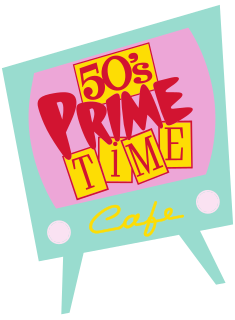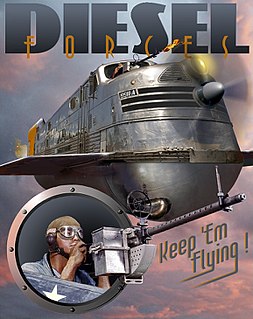 W
WRetro style is a style that is imitative or consciously derivative of lifestyles, trends, or art forms from the historical past, including in music, modes, fashions, or attitudes. It may also be known as "vintage inspired". In popular culture, the "nostalgia cycle" is typically for the two decades that are 20–30 years before the current one.
 W
WThe 50's Prime Time Café is a restaurant at Disney's Hollywood Studios, one of the four main theme parks at Walt Disney World. The restaurant replicates the kitsch of a 1950s diner. The waitresses dress similarly to Leave It to Beaver character June Cleaver, and each acts as though she is the mother of the guests she is serving, to the point of scolding and giving (mild) discipline to the patrons if they are "misbehaving". While eating, guests watch 1950s television shows such as Leave It to Beaver and Topper on black-and-white televisions.
 W
WAkishibu-kei is a loosely defined trend from the 2000s that involved an increase of Shibuya-kei influence in anime soundtracks. The term is a portmanteau of "Shibuya-kei" and "Akiba-kei". Both were 1990s cultural movements associated with musical and otaku interests, respectively, and Akishibu-kei was thought to have represented a merging of the two.
 W
WDepression glass is glassware made in the period 1929–1939, often clear or colored translucent machine-made glassware that was distributed free, or at low cost, in the United States and Canada around the time of the Great Depression. Depression glass is so called because collectors generally associate mass-produced glassware in pink, yellow, crystal, and green with the Great Depression in America.
 W
WDieselpunk is a retrofuturistic subgenre of science fiction similar to steampunk that combines the aesthetics of the diesel-based technology of the interwar period through to the 1950s with retro-futuristic technology and postmodern sensibilities. Coined in 2001 by game designer Lewis Pollak to describe his tabletop role-playing game Children of the Sun, the term has since been applied to a variety of visual art, music, motion pictures, fiction, and engineering.
 W
WThe Gigatron TTL is a retro-style 8-bit microcomputer, where the CPU is implemented by a set of TTL chips instead of a single microprocessor, imitating the hardware present in early arcades. Its target is the computing enthusiasts, for studying or hobby purposes.
 W
WHypnagogic pop is pop or psychedelic music that evokes cultural memory and nostalgia for the popular entertainment of the past. It emerged in the mid to late 2000s as American lo-fi and noise musicians began adopting retro aesthetics remembered from their childhood, such as radio rock, new wave pop, lite rock, video game music, synth-pop, and R&B. Recordings circulated on cassette or Internet blogs and were typically marked by the use of outmoded analog equipment and DIY experimentation.
 W
WThe Johnny Rockets Group Inc. is an American restaurant franchise whose themed decor is based upon 1950s diner-style restaurants. Décor includes Coca-Cola advertising, featuring nearly life-size cardboard illustrations of women in World War II armed services uniforms, individual jukebox stations, chrome accents and red vinyl seats.
 W
WRetrofuturism is a movement in the creative arts showing the influence of depictions of the future produced in an earlier era. If futurism is sometimes called a "science" bent on anticipating what will come, retrofuturism is the remembering of that anticipation. Characterized by a blend of old-fashioned "retro styles" with futuristic technology, retrofuturism explores the themes of tension between past and future, and between the alienating and empowering effects of technology. Primarily reflected in artistic creations and modified technologies that realize the imagined artifacts of its parallel reality, retrofuturism can be seen as "an animating perspective on the world".
 W
WRetrotronics is the making of electric circuits or appliances using older electric components, such as vacuum tubes, Nixie displays, relays, uniselectors, analogue meters, etc. These are usually chosen more for their aesthetic qualities than performance.
 W
WThe Sci-Fi Dine-In Theater Restaurant is a theme restaurant at Disney's Hollywood Studios, one of the four main theme parks at Walt Disney World in Bay Lake, Florida, United States. Established in May 1991, the restaurant is modeled after a 1950s drive-in theater. Walt Disney Imagineering designed the booths to resemble convertibles of the period, and some servers act as carhops while wearing roller skates. While eating, guests watch a large projection screen displaying film clips from such 1950s and 1960s films as Frankenstein Meets the Space Monster, Plan 9 from Outer Space, and Attack of the 50 Foot Woman.
 W
WShibuya-kei is a microgenre of pop music or a general aesthetic that flourished in the mid to late 1990s. Emerging as Japanese retail music from the Shibuya district of Tokyo, artists purveyed a cut-and-paste style that was inspired by previous genres based on kitsch, fusion, and artifice. Shibuya-kei draws heavily from 1960s culture and Western pop music, especially the orchestral domains occupied by producers Burt Bacharach, Brian Wilson, Phil Spector, and singer Serge Gainsbourg.
 W
WSteampunk is a retrofuturistic subgenre of science fiction that incorporates technology and aesthetic designs inspired by 19th-century industrial steam-powered machinery. Although its literary origins are sometimes associated with the cyberpunk genre, steampunk works are often set in an alternative history of the Victorian era or the American "Wild West", where steam power remains in mainstream use, or in a fantasy world that similarly employs steam power.
 W
WTales from the Loop is an alternate history science fiction tabletop role-playing game designed by Nils Hintze, based on the art of Simon Stålenhag. It was published in 2017 by Free League Publishing, the international arm of Swedish game and book publisher Fria Ligan AB, and Modiphius Entertainment. The game is built upon the Year Zero Engine created by Tomas Härenstam, who also served as the editor and project manager.
 W
WThe Teddy Boys or Teds were a mainly British subculture of young men wearing clothes partly inspired by the styles worn by dandies in the Edwardian period, which Savile Row tailors had attempted to re-introduce in Britain after the Second World War.
 W
WThrowback uniforms, throwback jerseys, retro kits or heritage guernseys are sports uniforms styled to resemble the uniforms that a team wore in the past. One-time or limited-time retro uniforms are sometimes produced to be worn by teams in games, on special occasions such as anniversaries of significant events.